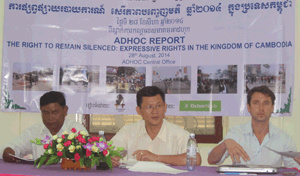 In testimony by witnesses this week, three former prisoners at S-21 have described their experiences of interrogations and beatings. Chum Mey and Bou Meng, in particular, recalled being asked about their alleged affiliation with the CIA or the KGB, even though they knew nothing about these agencies. Under the pressure of torture, Chum Mey, as well as many other prisoners at S-21, eventually “confessed” that he was an agent of the CIA. As Duch explained during his testimony, the interrogators blindly assumed that all of the prisoners who were arrested and sent to S-21 had been correctly identified as “enemies” of the regime. The interrogators thought that their only role was to extract confessions by any means available, rather than trying to discover the truth. So, who were the CIA and the KGB?
In testimony by witnesses this week, three former prisoners at S-21 have described their experiences of interrogations and beatings. Chum Mey and Bou Meng, in particular, recalled being asked about their alleged affiliation with the CIA or the KGB, even though they knew nothing about these agencies. Under the pressure of torture, Chum Mey, as well as many other prisoners at S-21, eventually “confessed” that he was an agent of the CIA. As Duch explained during his testimony, the interrogators blindly assumed that all of the prisoners who were arrested and sent to S-21 had been correctly identified as “enemies” of the regime. The interrogators thought that their only role was to extract confessions by any means available, rather than trying to discover the truth. So, who were the CIA and the KGB?
 The Khmer Rouge regime took power in Cambodia during a time of global conflict, often referred to as the “Cold War” between the United States and the Union of Soviet Socialist Republics. The communist USSR and the capitalist US waged a long war of attrition during the latter half of the twentieth century after the end of World War II. However, this war did not involve direct conflict on the battlefield between those two nations. Instead, it was a war fought through economic pressure, propaganda campaigns, localized wars fought indirectly through military coalitions within other nations, weapons development, and espionage. Their aim was not to acquire land or natural resources, but to spread each nation’s political ideology by supporting factions in other countries who had similar political aims and helping them to achieve dominance over the other parties. While the Soviet Union supported communist efforts in Vietnam, Korea, and South America, the U.S. supported opposing parties in those areas, with each side trying to increase the global power of its own ideology.
The Khmer Rouge regime took power in Cambodia during a time of global conflict, often referred to as the “Cold War” between the United States and the Union of Soviet Socialist Republics. The communist USSR and the capitalist US waged a long war of attrition during the latter half of the twentieth century after the end of World War II. However, this war did not involve direct conflict on the battlefield between those two nations. Instead, it was a war fought through economic pressure, propaganda campaigns, localized wars fought indirectly through military coalitions within other nations, weapons development, and espionage. Their aim was not to acquire land or natural resources, but to spread each nation’s political ideology by supporting factions in other countries who had similar political aims and helping them to achieve dominance over the other parties. While the Soviet Union supported communist efforts in Vietnam, Korea, and South America, the U.S. supported opposing parties in those areas, with each side trying to increase the global power of its own ideology.
Each nation had its own well-funded, extremely powerful, global network of spies and informers. The United States used the Central Intelligence Agency, or CIA, and the Union of Soviet Socialist Republics, used the KGB, or Komitet gosudarstvennoi bezopasnosti (“Committee of State Security”). Both of these organizations were given wide discretion to do virtually anything necessary to accomplish their goals. They conducted secret, often illegal activities all over the world, including espionage, torture, and assassinations. They often sent spies into enemy governments to collect secret information and spread false information in order to weaken other regimes. One of the major theaters of this war was SE Asia. During the Vietnam War, the CIA sent many agents and spies into Vietnam and Laos. The CIA also suspected that the North Vietnamese army had established a headquarters in Cambodia. Prince Norodom Sihanouk claimed that the CIA had engineered the coup that expelled him in March 1970. In 1970, Lon Nol received millions of dollars in aid from the US government because he took a stronger stance against the North Vietnamese than Prince Sihanouk had done. The devastation caused by US bombings of areas of Cambodia where the North Vietnamese were staying was one of the reasons for the increasing popularity of Pol Pot’s communist Khmer Rouge regime, which deposed Lon Nol in 1975. Yet, there is no evidence that the CIA attempted to send spies to infiltrate the Khmer Rouge.
So why did the Khmer Rouge accuse the prisoners of S-21 of working for the CIA? On Tuesday, 30 June 2009, Chum Mey asked Duch this very question, and he responded that, “the term CIA was used to arrest those against the organization…they were not really CIA agents employed and appointed by the US…[the accusations were only a pretext] to arrest people like you who were against [the Khmer Rouge].” Previously, Duch has admitted that he knew even then that many of the coerced confessions from alleged enemies were false. The Khmer Rouge leaders invented their concept of “the enemy” to create fear, to perpetuate their extreme ideology, and to justify their exercise of brutal authoritarian power.

